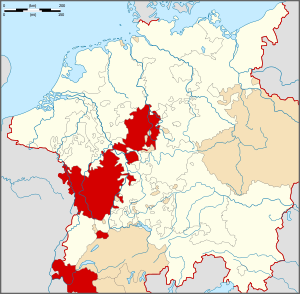Prince-Bishopric of Basel
The Prince-Bishopric of Basel (German: Hochstift Basel, Fürstbistum Basel, Bistum Basel) was an ecclesiastical principality within the Holy Roman Empire, ruled from 1032 by Prince-Bishops with their seat at Basel, and from 1528 until 1792 at Porrentruy, and thereafter at Schliengen. The final dissolution of the state occurred in 1803 as part of the German Mediatisation.
Prince-Bishopric of Basel Fürstbistum Basel | |||||||||||
|---|---|---|---|---|---|---|---|---|---|---|---|
| 1032–1803 | |||||||||||
 Coat of arms
| |||||||||||
 The Prince-Bishopric in the 18th century | |||||||||||
| Status | Prince-Bishopric | ||||||||||
| Capital |
| ||||||||||
| Common languages | Franc-Comtais, High Alemannic | ||||||||||
| Government | Elective principality | ||||||||||
| History | |||||||||||
• Diocese established | 740 | ||||||||||
• Elevated to Prince-Bishopric | 1032 | ||||||||||
| 1495 | |||||||||||
• Swiss Reformation | 1528 | ||||||||||
| 1797 | |||||||||||
• Mediatised to Baden | 1803 | ||||||||||
| |||||||||||
The Prince-Bishopric comprised territories now in the Swiss cantons of Basel-Landschaft, Jura, Solothurn and Bern, besides minor territories in nearby portions of southern Germany and eastern France. The city of Basel ceased to be part of the Prince-Bishopric after it joined the Swiss Confederacy in 1501.
History
The city of Basel became an episcopal seat in ca. 740, continuing the 4th century diocese of Augusta Raurica. In 999, Rudolph III of Burgundy presented the bishop of Basel with the Abbey of Moutier-Grandval, establishing the bishopric as a secular vassal state of Burgundy with feudal authority over significant territories. After the death of Rudolph in 1032, the vassalage was converted to imperial immediacy, elevating the Bishop of Basel to the status of Prince-Bishop, ranking as an ecclesiastical Reichsfurst of the Holy Roman Empire.
The Prince-Bishopric reached the peak of its power during the late 12th to early 14th centuries.
In the course of the 14th century, financial difficulties forced the bishops of Basel to sell parts of their territory. During the 15th century, however, a number of politically and militarily successful bishops managed to regain some of the previously lost territories and Basel began to align itself with the Old Swiss Confederacy as an "associated city" (Zugewandter Ort).
Basel became the focal point of western Christendom during the 15th century Council of Basel (1431–1449), including the 1439 election of antipope Felix V. In 1459 Pope Pius II endowed the University of Basel where such notables as Erasmus of Rotterdam and Paracelsus later taught. Following the Imperial Reform of 1495, the prince-bishopric was part of the Upper Rhenish Circle of the Imperial Circle Estates.
In the 16th century the city of Basel and its surrounding territory acceded to the Old Swiss Confederacy (1501) as the Canton of Basel. After the city of Basel joined the Swiss Reformation (1528), the prince-bishop established his residence in Porrentruy, from where he could cross into France nearby in case of disorders or attacks. The secular rule of the Prince-Bishops from this time was mostly limited to territories west of Basel, more or less corresponding to the modern canton of Jura.
The Prince-Bishopric lost the bulk of its remaining territories to the Rauracian Republic in 1792 (revolutionarly converted into the French département of Mont-Terrible in the following year), while the treaty of Campo Formio in 1797 gave international recognizance to the French annexation, which could be expanded to all the bishopric territory (while Switzerland received Austrian Fricktal as indemnity), which retained Schliengen as its sole dominion. Schliengen was made part of the Margraviate of Baden in the resolution of the Reichsdeputationshauptschluss of 1803, discontinuing the status of the bishops of Basel as secular rulers.
- Basel Minster and Palace, until the Swiss Reformation in 1529 cathedral and residence of the prince-bishops
 Porrentruy Castle, 1527–1792 exile residence of the prince-bishops
Porrentruy Castle, 1527–1792 exile residence of the prince-bishops
Territories

By the 16th century, the Prince-Bishopric of Basel comprised:



- Amt of Birseck















The Prince-Bishopric also held the following territories, which were lost before 1527:
See also
- List of bishops of Basel
- History of Basel
References
- Prince-Bishopric of Basel in German, French and Italian in the online Historical Dictionary of Switzerland.
